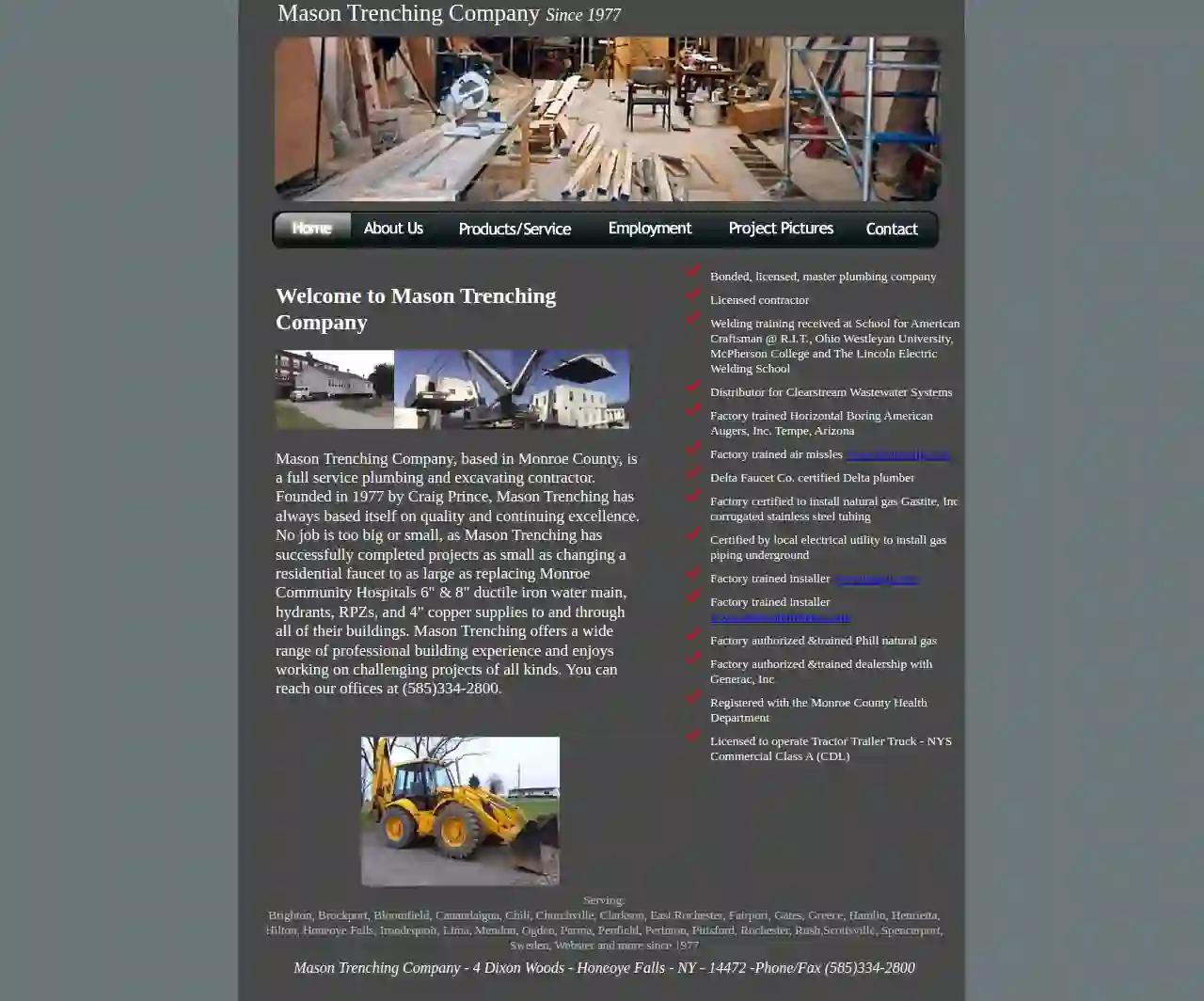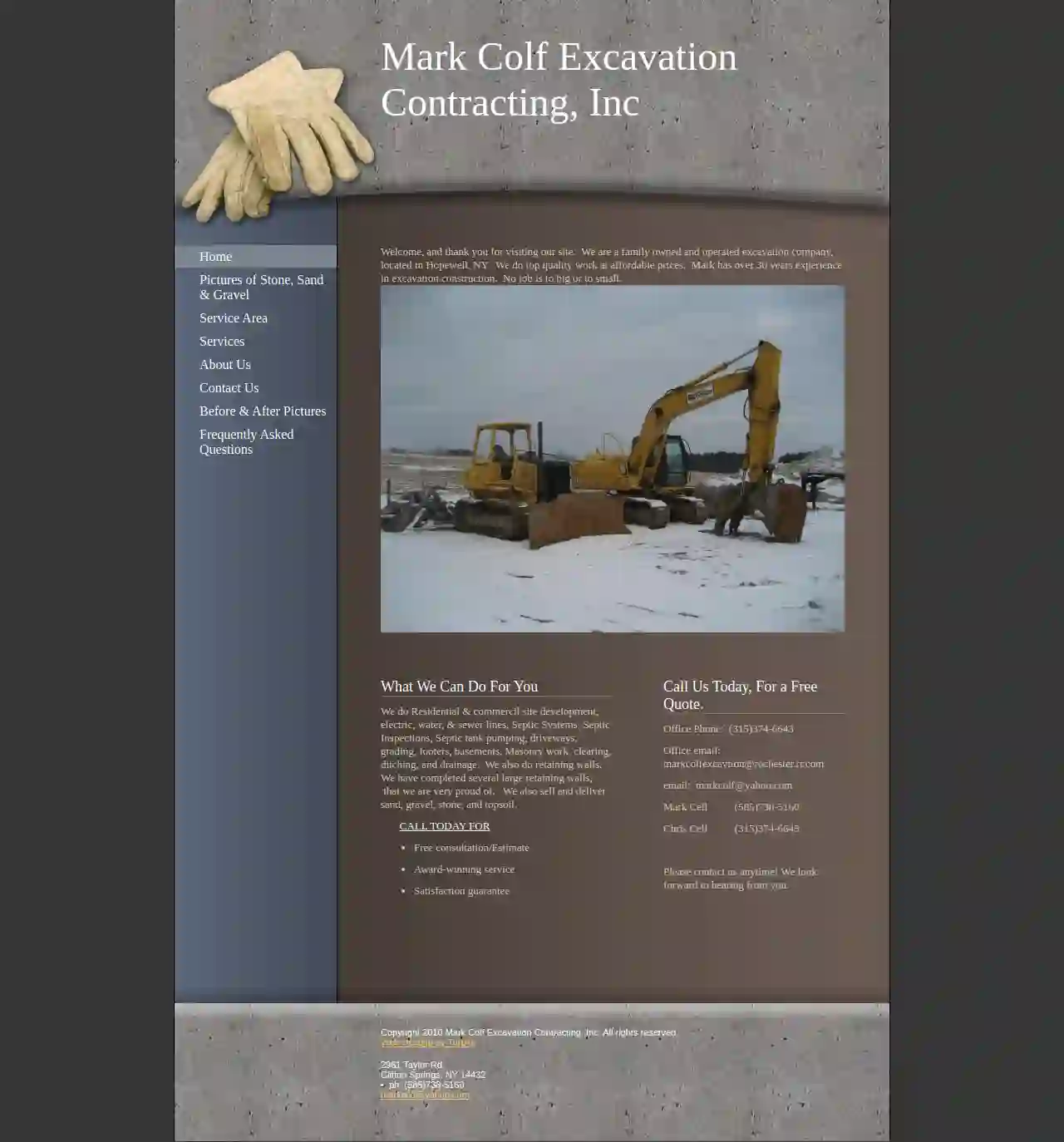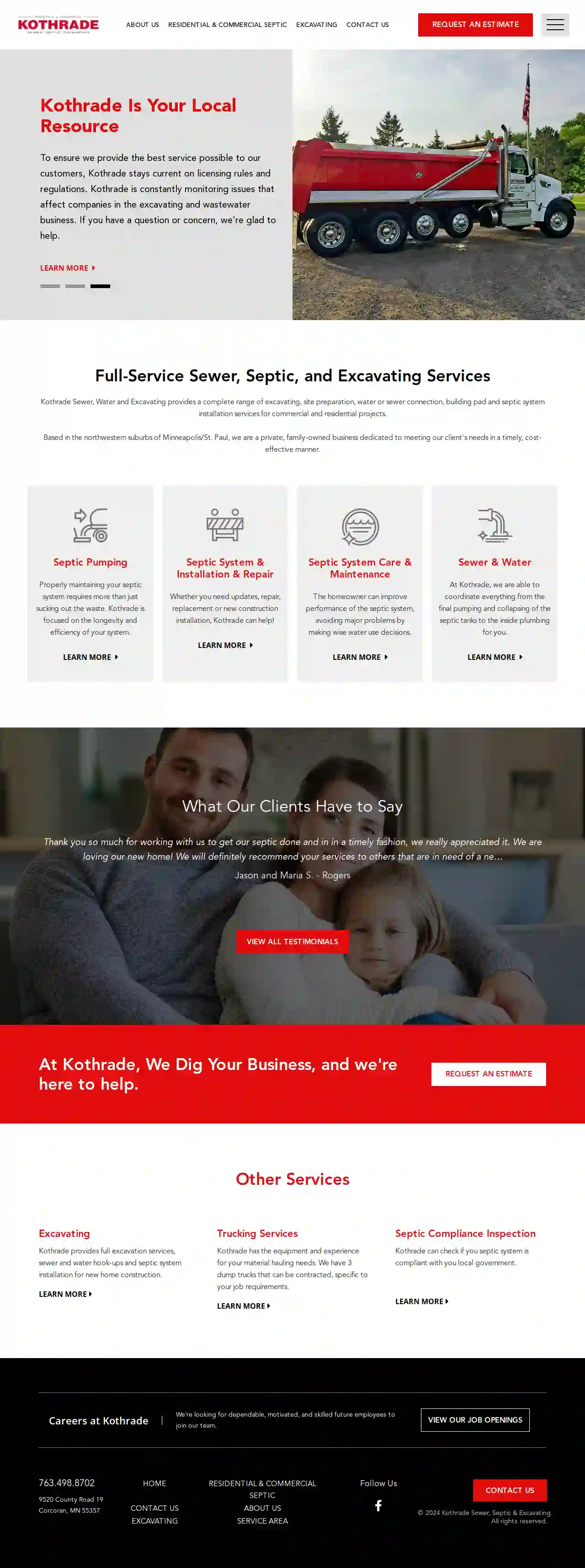Excavation Contractors Watertown
Top 10 Excavation Services in Watertown
Get multiple Digging Contractors quotes for your project today! Compare profiles, reviews, accreditations, portfolio, etc... and choose the best service.

Mason Trenching
52 reviews4 Dixon Woods, Honeoye Falls, 14472, USAbout Mason Trenching Mason Trenching is a bonded, licensed, master plumbing contractor with over 4 million dollars in insurance. We've been serving the Monroe County area for over 30 years, completing projects ranging from simple residential faucet replacements to large-scale infrastructure upgrades like replacing Monroe Community Hospital's water main system. We're known for our commitment to quality, expertise, and exceeding expectations on every project. Our team is experienced in building jacking, rigging, and building relocation, including complete renovations. We've tackled challenging projects like supporting and restoring foundations for the Rochester Institute of Technology after a ground water collapse, installing gas furnaces in dormitories, and relocating a 2,500 sq. ft. Victorian house 500 ft. uphill with a 60 ft. grade change. We've also moved a 4,500 sq. ft. historic Greece Revival house 14 miles, setting a record for the widest load ever transported on State Roads in Monroe County. We're proud to have completed sewer projects for Groveland Prison, exceeding expectations on time and budget, and earning a spot on the emergency contractor list for NYS projects. We've also completed extensive storm sewer, manhole, catch basin, sidewalk, and bridgework on Route 64 for the Town of Pittsford and the State of New York. We're registered with the Monroe County Health Department and have installed one of the largest private raised fill septic systems in Brighton, approved in a flood plain. We're a distributor for Clearstream Wastewater Systems, Inc., offering certified sewage treatment plants that can process from 500 to 1,000,000 gallons per day. Our treatment systems are so clean they've received government approval for direct release into storm sewers or streams. Our team is bonded and has received clearance to work in various environments. We're committed to providing exceptional service and exceeding your expectations on every project.
- Services
- Why Us?
- Gallery
Get Quote
Mark Colf Excavating
4.99 reviews2961 Taylor Rd., Clifton Springs, 14432, USMark Colf Excavation Contracting, Inc. Mark Colf Excavation Contracting, Inc. is a family owned and operated excavation company, located in Canandaigua, NY. We are committed to providing top quality work at affordable prices. Mark has over 30 years experience in excavation construction. No job is too big or too small. We are dedicated to providing our customers with the highest level of service and satisfaction. We are proud of the work we do and we stand behind it 100%. We offer a wide range of services, including: Residential & commercial site development Electric, water, & sewer lines Septic systems Septic inspections Septic tank pumping Driveways Grading Footers Basements Masonry work Clearing Ditching Drainage Retaining walls Topsoil, sand, gravel, stone, water delivery We also offer a waterless toilet, perfect for cabins, golf courses, public buildings, concerts, and more. We are committed to providing our customers with the highest level of service and satisfaction. We are proud of the work we do and we stand behind it 100%. Contact us today for a free consultation and estimate.
- Services
- Why Us?
- Our Team
- Testimonials
- Gallery
Get Quote
The Rochester Hills Excavating Company
52 reviewsRochester, USWelcome to The Rochester Hills Excavating Company We take great pride in pioneering excellence in excavation services. With a steadfast commitment to quality, safety, and client satisfaction, we have emerged as a leading excavating company in Rochester Hills, Illinois. Our journey of over two decades has been marked by innovation, a highly skilled workforce, and state-of-the-art equipment, making us the go-to choice for a wide range of excavation and site preparation needs. As we share our story with you, we invite you to explore the core values that drive us, the comprehensive services we offer, and our unwavering dedication to delivering outstanding results. Our Foundation and Values From the outset, we embraced a set of core values that became the guiding principles of our company: 1. Integrity: We operate with utmost honesty and integrity, building trust with our clients, partners, and employees. 2. Excellence: Striving for excellence is at the heart of everything we do. We are committed to delivering top-quality workmanship that exceeds expectations. 3. Safety: The safety of our team members and clients is of paramount importance. We uphold rigorous safety standards and invest in continuous training to prevent accidents and create a secure work environment. 4. Innovation: Embracing innovation is key to our success. We continuously explore new technologies and techniques to improve our services and efficiency. 5. Client-Centric Approach: Our clients are at the center of our operations. We listen to their needs, collaborate closely, and tailor our services to meet their specific requirements. Comprehensive Excavation Services At The Rochester Hills Excavating Company, we offer a comprehensive suite of excavation services designed to address the diverse needs of our clients. From small-scale residential projects to large commercial ventures, we have the expertise and resources to handle projects of varying complexities. Our services include: 1. Site Preparation: Our site preparation services set the stage for successful construction projects. We clear debris, grade the land, and prepare the site for the construction process. 2. Earthmoving: With our modern fleet of excavators and bulldozers, we efficiently move earth to create the desired landscape for construction. 3. Land Clearing: Our land clearing services ensure that your site is free from overgrowth, obstacles, and debris, allowing for a clean canvas to begin construction. 4. Grading: Precise grading is essential for a stable and level foundation. Our skilled operators use advanced grading equipment to ensure that your site is properly graded for construction.
- Services
- Why Us?
- Gallery
Get Quote
Trinity Landscaping & Excavating Inc.
532 reviews19910 Larkin Rd, Hamel, 55343, USFamily owned and operated, Trinity Landscaping & Excavating, Inc. was established in 2000, and we have an amazing reputation of helping our customers in redesigning their yards, property and businesses to emerge with exactly the look they desire. Trinity Landscaping & Excavating, INC. offers services for both residential and commercial. Landscaping, excavating, demolition, storm damage clean-up, equipment rental and concrete work: sidewalks, driveways, patios, decorative concrete and floors. All the services we provide are extensive and detailed. We will be there during the initial planning, and we will still be there when you are making the final inspection. We at Trinity Landscaping and Excavating, Inc. pride ourselves on our dedication and professionalism, and it is these qualities you can always trust. We service St. Cloud, Minneapolis, St. Paul & the entire Twin City Metro.
- Services
- Why Us?
- Testimonials
- Gallery
Get Quote
All Service North - Excavating, Grading and Septic
542 reviewsBrook Park, 55007, USAll Service North A Firefighter, Husband and Wife Owned Excavation Business Serving North Central Minnesota All Service North is a firefighter husband and wife-owned excavation business located in North Central Minnesota. With a strong foundation in transparency, communication, and delivering results, we have been dedicated to providing top-notch excavation and contracting services. Our core values guide everything we do. We believe in open and honest communication with our clients, ensuring that you are informed every step of the way. Our commitment to delivering exceptional results sets us apart in the industry, as we strive for excellence in every project we undertake. Whether you require excavation, land clearing, septic systems, or a new driveway, trust the expertise and dedication of the All Service North team. Experience the difference our core values can make for your next project.
- Services
- Why Us?
- Testimonials
- Gallery
Get Quote
Mortenson Company
4.585 reviewsSan Antonio, TX, USLet's Redefine Possible. We are a top 25 builder and developer fully invested in our customers’ success and improving the communities in which we live and work. We’re a construction industry leader in markets like sports facilities, renewable energy, data centers and healthcare. At the end of the day, we want to be known for making sure the built environment has a lasting positive impact and strive to make your project better than you imagined possible. A Career With Mortenson Join the team at Mortenson and take your career to new heights. Be a part of our dynamic and inclusive culture - one that values teamwork, unique perspectives, innovation, and personal development. What will you build? Explore careers Your Project Partner Your project can make or break reputations and bottom lines. We get it. That's why we serve as your project partner and guide, every step of the way. view our projects Industry Experience From inspiring and productive spaces to clean energy and reliable infrastructure, we offer a unique portfolio of services that invite you to not only dream bigger but dream better. industries we serve
- Services
- Why Us?
- Testimonials
- Gallery
Get Quote
Shamrock Paving
4.335 reviews841 Buffalo Rd., Rochester, 14624, USOver 30 Years of Superior Paving & Asphalt Service in Rochester NY For over 30 years, the asphalt specialists at Shamrock Paving in Rochester have been working hard to build a reputation of honesty and integrity. Get in touch and discover why the road to success begins with Shamrock! The Road to Success Begins with Shamrock Paving Most homeowners and businesses don’t spend much time thinking about the state of their asphalt or paved surfaces. But when the time comes to have them installed or repaired, you need the assurance of proven professionals who see the importance of every job from your point of view. At Shamrock Paving, we take great measures to ensure perfection from start to finish. All employees are OSHA and Hazmat certified, and we’re fully insured to protect you and your property. About Shamrock Paving – We Pave with Pride With over 30 years of collective experience and a full offering of commercial and residential asphalt services, Shamrock Paving has been working hard over the years to build a reputation as one of the most talented and trusted paving companies in Rochester NY. Whether you’re a homeowner, a thriving local business, or a contractor in need of consistently reliable pavement services, Shamrock is here to make each project a flawless success from start to finish. Here are just a few of the reason why so many others in the area continue to place their trust in our professional asphalt and sealcoating services. Get in touch to learn more and discuss your upcoming project! Reputation We may have humble roots, but today Shamrock has grown to become one of the Rochester area’s most respected asphalt & sealcoating companies. We treat every job as if it were our own home or business, and go to great lengths in earning your trust and business for a lifetime. Expertise Our team of sealcoating and asphalt techs include professions from a wide array of industry; each one bringing extensive training and proven expertise in their respective fields. Together, this allows Shamrock to offer a full spectrum of residential and commercial services of the highest caliber. Affordable Value Even from our onset we learned the benefits of smart partnerships, controlling overhead and making wise operational decisions. Today, these and many other factors make it possible for Shamrock to provide asphalt services at the highest level without charging a small fortune.
- Services
- Why Us?
- Gallery
Get Quote
Kothrade Sewer Water & Excavating
4.614 reviews9520 County Rd 19, Corcoran, 55357, USExceptional Service: The Core of Our Business In business since 1994, Kothrade Sewer, Septic and Excavating focus on providing quality, comprehensive services to local businesses, developers, homeowners, and government agencies/municipalities. We are your local experts on pumping, troubleshooting, certification and much more. We're always here for you! Residential & Commercial Services For prompt, expert and reliable solutions, Kothrade has the high-quality equipment and seasoned experience to meet your company needs and budget. We comply with all the state mandated environmental rules. Kothrade Is Your Local Resource To ensure we provide the best service possible to our customers, Kothrade stays current on licensing rules and regulations. Kothrade is constantly monitoring issues that affect companies in the excavating and wastewater business. If you have a question or concern, we're glad to help. Full-Service Sewer, Septic, and Excavating Services Kothrade Sewer, Water and Excavating provides a complete range of excavating, site preparation, water or sewer connection, building pad and septic system installation services for commercial and residential projects. Based in the northwestern suburbs of Minneapolis/St. Paul, we are a private, family-owned business dedicated to meeting our client's needs in a timely, cost-effective manner.
- Services
- Why Us?
- Testimonials
- Gallery
Get Quote
B-C Excavating, Inc.
56 reviews4503 Lyell Road, Rochester, NY, 14606, USOur History It all began in 1974 when Louis J. Brongo, a hard working father of 8 children, made a life changing decision to get ahead in life. Louis J. worked as a shovel operator for a company, digging basements for new homes. This is where he met a business partner, and the two invested in some equipment to work for themselves throughout Monroe County. They still concentrated on digging basements, but also started excavating land for farmers and digging trenches for sewer & water lines. In early 1980, Louis R. Brongo joined the business, bringing experience from working with other local construction companies. After a few years (when the founding partners both decided to part ways) Louis J. and his son, Louis R., bought out the partner, officially making B-C Excavating, Inc, a family-owned business. Louis R. started cutting and selling firewood at the young age of 13 to make some money. He noticed at job sites that the contractors wanted trees, brush and stumps either buried on site or hauled away. Recognizing the opportunity to recycle wood into firewood, B-C Excavating, Inc. started offering land clearing services. As the demand for this service increased, our company focus shifted to land clearing. We purchased some specialized forestry equipment and started land clearing with the intent of recycling all the material from each job. Three generations later… This passion for land clearing certainly runs in our bloodline! 1974- Louis J. Brongo begins a new company specializing in digging basements, excavating land for farmers, and digging trenches for water & sewer lines. Early 1980s- Louis R. Brongo joins the business, and the company begins offering land clearing and firewood services. 1999- Jason Brongo joined the company, operating equipment and working in the field 2001- Jennifer (Brongo) Mesh begins working in the office. 2002- Joshua Brongo joined B-C Excavating, Inc.. After a few years with us, he went off to start his own tree company. We are a multi-generational family owned and operated company… When you choose B-C Excavating, Inc.-- you work directly with one of the owners. We take great pride in our work, maintaining a good reputation, and offering fair pricing with an experienced and professional operating crew to complete jobs efficiently. We recycle all trees, brush and stumps from land clearing jobs into log loads, mulch, wood chips and firewood. Nothing-- from any land clearing job-- goes to waste. We work mainly for contractors,
- Services
- Why Us?
- Our Team
- Gallery
Get Quote
Christa Construction LLC
44 reviews64 Commercial Street, Suite 401, Rochester, 14614, USBuilt on a Foundation of Quality and Service That's the Christa Difference. Protecting our People Safety as our Priority. Comprehensive Solutions That Drive Up Value Exceeding our client's requirements time and time again. Over 40 years of projects completed on time and on budget. Christa’s depth of knowledge and experience is built on a foundation of quality and service. It is this philosophy and dedication to cultivating dynamic business relationships that has spurred our vigorous growth. For over four decades we have consistently produced positive results – projects completed on time and within budget. We put forth a focus on our client’s needs, taking on a proactive approach in every project, from preconstruction to the ribbon cutting. As a result we have become an industry leading organization known for our commitment to provide “Client Satisfaction Through Quality, Service and Value” consistently exceeding our clients’ expectations. That’s the Christa Difference. Hear what our clients have to say about us! We’re built on strong family values. A progressive workplace supported by state-of-the-art technology with creative thinking that demonstrates our commitment to hiring and retaining the best people in the industry. Get to know our team
- Services
- Why Us?
- Gallery
Get Quote
Over 22,076+ Excavation Pros in our network
Our excavation pros operate in Watertown & surrounding areas!
ExcavationHQ has curated and vetted Top Excavation Contractors arround Watertown. Find the most trustworthy pro today.
Frequently Asked Questions About Excavation Contractors
- Sloped Property: Your property has a significant slope, making it prone to soil erosion or landslides.
- Creating Usable Space: You want to level off a sloped area to create a flat surface for patios, gardens, or other outdoor spaces.
- Preventing Damage: Erosion is threatening existing structures, driveways, or walkways.
- Landscaping Features: You're incorporating tiered gardens, raised beds, or other landscaping elements requiring soil retention.
- Excavators: Versatile machines with a bucket, arm, and rotating cab for digging, lifting, and moving earth.
- Backhoes: Similar to excavators but with a digging bucket on the back and a loader bucket on the front, ideal for trenching and smaller excavations.
- Bulldozers: Powerful machines with a large blade for pushing earth, clearing land, and leveling surfaces.
- Skid Steers: Compact and maneuverable loaders with various attachments (buckets, forks) for digging, loading, and grading in tight spaces.
- Trenchers: Specialized machines for digging narrow trenches for utilities.
- Dump Trucks: Vehicles for hauling excavated material to disposal sites.
- Mechanical Excavation: Utilizing heavy equipment like excavators, backhoes, bulldozers, and loaders, suitable for most projects.
- Hand Excavation: Using hand tools (shovels, picks) for smaller excavations or delicate work near utilities.
- Blasting: Employing explosives to break up rock or hard materials, typically for large-scale projects.
- Hydro Excavation: Using high-pressure water jets to loosen and remove soil, often used for locating utilities or delicate excavation.
- Vacuum Excavation: Employing a vacuum system to suck up excavated material, suitable for safe excavation near utilities or in confined spaces.
- Trench Collapses: Unstable trench walls can cave in, posing a severe risk to workers. Proper shoring and sloping are crucial safety measures.
- Utility Damage: Striking underground utilities (gas, water, electric) can cause leaks, explosions, or electrocution. Accurate utility locates and careful digging are essential.
- Falling Objects: Materials or equipment falling into excavations can injure workers. Securing work areas and using appropriate safety gear is vital.
- Equipment Accidents: Operating heavy machinery involves risks of rollovers, collisions, or mechanical failures. Trained operators and proper equipment maintenance are critical.
- Environmental Hazards: Excavated soil might contain hazardous materials (asbestos, lead). Proper testing and disposal procedures are necessary.
How do I know if I need a retaining wall?
What equipment is used for excavation?
What are the different methods of excavation?
What are the risks associated with excavation?
How do I know if I need a retaining wall?
- Sloped Property: Your property has a significant slope, making it prone to soil erosion or landslides.
- Creating Usable Space: You want to level off a sloped area to create a flat surface for patios, gardens, or other outdoor spaces.
- Preventing Damage: Erosion is threatening existing structures, driveways, or walkways.
- Landscaping Features: You're incorporating tiered gardens, raised beds, or other landscaping elements requiring soil retention.
What equipment is used for excavation?
- Excavators: Versatile machines with a bucket, arm, and rotating cab for digging, lifting, and moving earth.
- Backhoes: Similar to excavators but with a digging bucket on the back and a loader bucket on the front, ideal for trenching and smaller excavations.
- Bulldozers: Powerful machines with a large blade for pushing earth, clearing land, and leveling surfaces.
- Skid Steers: Compact and maneuverable loaders with various attachments (buckets, forks) for digging, loading, and grading in tight spaces.
- Trenchers: Specialized machines for digging narrow trenches for utilities.
- Dump Trucks: Vehicles for hauling excavated material to disposal sites.
What are the different methods of excavation?
- Mechanical Excavation: Utilizing heavy equipment like excavators, backhoes, bulldozers, and loaders, suitable for most projects.
- Hand Excavation: Using hand tools (shovels, picks) for smaller excavations or delicate work near utilities.
- Blasting: Employing explosives to break up rock or hard materials, typically for large-scale projects.
- Hydro Excavation: Using high-pressure water jets to loosen and remove soil, often used for locating utilities or delicate excavation.
- Vacuum Excavation: Employing a vacuum system to suck up excavated material, suitable for safe excavation near utilities or in confined spaces.
What are the risks associated with excavation?
- Trench Collapses: Unstable trench walls can cave in, posing a severe risk to workers. Proper shoring and sloping are crucial safety measures.
- Utility Damage: Striking underground utilities (gas, water, electric) can cause leaks, explosions, or electrocution. Accurate utility locates and careful digging are essential.
- Falling Objects: Materials or equipment falling into excavations can injure workers. Securing work areas and using appropriate safety gear is vital.
- Equipment Accidents: Operating heavy machinery involves risks of rollovers, collisions, or mechanical failures. Trained operators and proper equipment maintenance are critical.
- Environmental Hazards: Excavated soil might contain hazardous materials (asbestos, lead). Proper testing and disposal procedures are necessary.